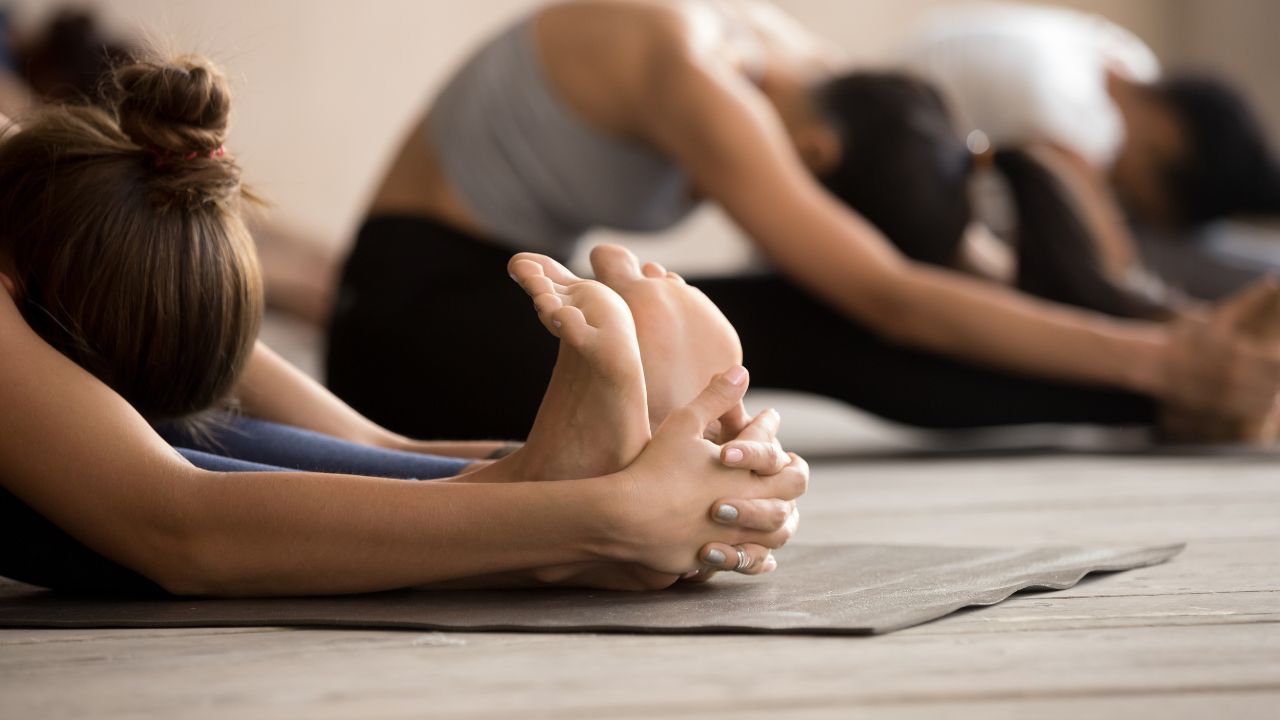Seated Forward Bend (Paschimottanasana)

Seated Forward Bend, or Paschimottanasana, is a seated yoga pose that stretches the entire back body, including the spine, hamstrings, and calves. It promotes flexibility, relaxation, and introspection. Here’s how to practice Seated Forward Bend:
- Start by sitting on a yoga mat with your legs extended in front of you. Sit up tall and lengthen your spine.
- Engage your quadriceps by flexing your feet and pressing your heels down into the mat. This will help protect your knees and enhance the stretch.
- On an inhale, raise your arms overhead, lengthening your spine even more. Feel the lift and elongation from your tailbone to the crown of your head.
- On an exhale, hinge forward from your hips, leading with your chest. Keep your spine long as you fold forward. Reach your hands toward your feet, ankles, or shins, depending on your flexibility. If you’re not able to reach your feet, you can use a yoga strap or hold onto your calves.
- As you fold forward, focus on lengthening your spine rather than collapsing. Allow your head and neck to relax. You can choose to keep your gaze forward or soften your gaze downward.
- Breathe deeply and relax into the pose with each exhale. As you hold the pose, you may find that you can deepen the stretch and fold a little further with each breath.
- If you feel any discomfort or strain in your lower back or hamstrings, you can modify the pose by placing a folded blanket or bolster under your sitting bones to elevate your hips slightly.
- Hold Seated Forward Bend for several breaths or for as long as feels comfortable for you. Aim to stay in the pose for at least 30 seconds to a minute to experience its full benefits.
- To release the pose, inhale and slowly come back up to an upright seated position, using your core muscles to lift your torso.
Some key points to remember while practicing Seated Forward Bend:
- Focus on lengthening your spine and folding forward from your hips rather than rounding your back.
- Relax and surrender into the pose with each breath, allowing the stretch to unfold naturally.
- Avoid any sharp or intense pain. The stretch should feel intense but not painful. If you feel discomfort, back off slightly and find a position that suits your body’s needs.
Benefits of Seated Forward Bend include:
- Stretches the entire back body, including the spine, hamstrings, and calves.
- Calms the mind and promotes relaxation.
- Relieves tension in the back, shoulders, and neck.
- Stimulates digestion and massages the abdominal organs.
- Enhances flexibility and suppleness of the spine.
As with any yoga pose, listen to your body and practice mindfully. If you have any specific concerns or limitations, it’s advisable to consult with a qualified yoga teacher for guidance. Enjoy the lengthening and grounding effects of Seated Forward Bend.
Specific Content Keywords : seated forward bend benefits,janu sirsasana
paschimottanasana procedure,paschimottanasana definition,how to improve paschimottanasana,10 benefits of paschimottanasana,seated forward fold variations,paschimottanasana for beginners,seated forward bend (paschimottanasana),seated forward bend paschimottanasana steps,paschimottanasana (seated forward bend yoga pose),seated forward bend instructions,how to do seated forward bend,why can’t i do seated forward bend.

